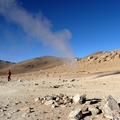World Tourism / The Most Impressive Geysers on the Earth / Sol de Manana Geyser, Bolivia
Sol de Manana Geyser, Bolivia
Bolivia lies on a golden throne and it is very rich in natural resources : gold, tin and it serves as a great tourist attraction for many people.
Location
Sol de Manana is an area of approximately 2 km ² in extent, located in the department of Potosi , Bolivia , south of Laguna Colorada in the way to the Salar de Chalviri at an altitude of 4,850 meters within the National Reserve Andean Fauna Eduardo Abaroa .The best time to visit the place is in the morning as you can watch the geysers boiling and the sun rising at the same time. There are more than 50 mud pools in the region.
The highest geyser field in the world
Sol de Manana is a geothermal field, mainly a collection of mud pots in Surah Lípez province of Potosi Department in southwestern Bolivia. It extends over 10 km ², between 4800 and 5000 m altitude above the sea level. This is the highest geyser field in the world. It is characterized by intense volcanic activities and fumaroles, and got its name because it is too early in the morning, at sunrise, when the temperature differs between the air and the steam, in addition to the coverage of the sun, to increase its fame.
Description
This area is characterized by intense volcanic activity including fumaroles and geysers . The craters are located in the region where lava is boiling intensively, in addition, fumaroles and geysers emit vapors mixed with water and steam heat reaching heights of 10 to 50 meters , due to the pressure with which they are issued. These events allow us to appreciate amazing landscape. It seems it takes us back to the times of formation of the Earth. The geyser soil of Manana, Bolivia is characterized by intense volcanic activity. Many pools are lava geysers.
The place offers picturesque and spectacular landscapes unique to Bolivian land. It is interesting to observe the life of the geysers. When they are calm, the main and secondary depressions are filled with light blue water and sulfide .But later from the depths of the earth, a rumble is heard, and soon small clouds of steam are rising above the basin. Then all stops to happen again.
Others from The Most Impressive Geysers on the Earth
Geysers are one of the manifestations of later stages of volcanism , and common areas of modern volcanic activity provided by hydrogeological conditions.
Being an intermittent hot water spring and vapor, volcanic, throwing water at regular intervals, to the sea lifting time form of a column, a geyser occurs if the activity of a volcano is at a late stage.
Large assets of geysers in the world are few , but they are of a rare beauty and fascination.
They are a pride and remarkable natural phenomena for the states where they are situated .
No matter what shape, cone-like or like fountains, geysers are rare as they need an almost perfect balance of heat and water conditions and the right rock and channeling.
Best spots of geysers in the world There are few best spots of geysers in the world.
There are only about a thousand geysers in the world situated on some major geothermal areas with geysers force on the Earth: Yellowstone Plateau in the U.
S.
A.
(where it is concentrated about half of all existing geysers), Iceland, New Zeeland( 58 geysers), Kamchatka, Chile, Papua New Guinea ( 38 active geysers), Indonesia( Sumatra Island – 17 geysers), Eastern Africa ( 6 geysers), China ( 10 geysers), Japan ( 4 geysers), Ethiopia and Kenya( very few).
Europeans first learned about the Icelandic geysers in the thirteenth century.
Yellowstone geysers were far from the civilized world until of the first decade of the nineteenth century.
John Colter ‘s stories were perceived as nonsense for too long time.
It took more than fifty years, unless specific expedition with the participation of artists and photographers convinced people of the existence of the world's largest geyser fields in the super-giant caldera of the dormant.
In 1872, Yellowstone geysers were under the protection of the world's first national park.
In 1850, a missionary from R.
Taylor became aware of the geysers in New Zealand.
It was only in 1941 that is only recently in historical terms, has been committed by one of the last great geographical discoveries on the planet.
Thegeologist T.
Ustinova and the conductor Alexander Krupenin, apparently, were the first humans to set foot on the shore of the river called Geyser.
What threatens the geysers? How long do they live? In some parts of the world geothermal geysers are simply former constructions.
In the 19th century , New Zealand North Island had five major geyser fields, which erupted about 220 geysers, now it has only 58 geysers, some of them quite small.
The reasons for the disappearance of New Zealand's geysers are different : natural disasters (volcanic eruption of Tarawera, changes on the groundwater levels), the drilling for the construction of thermal power plants, flooding during the construction of hydroelectric power.
The most powerful geyser on the Earth , Waimangu existed in New Zealand from 1899 to 1904.
With each eruption, it threw about 800 tons of water and trapped many jet stones raised by half a kilometer high.
There are even cases of death, found themselves too close to the erupting from the giant.
But Waimangu stopped working due to the lower water levels in the nearby lake.
Geysers are valuable destinations in the world.
A fascinating circuit where you can live unforgettable moments is visiting spectacular attractions such as the mysterious geysers.
They offer fascinating landscapes where majestic volcanoes and impressive lava formations are found together.
If you are a geyser fan, we offer a selection of the most beautiful and largest geysers in the world.





























